Kansas is well-known for a number of representative symbols, but we have no state fruit. Other states have a state fruit, but not us. Why is that? Well, for one thing, state symbols are not pressing business within the branches of our government. Just like the Kansas state insect, the honeybee, it is up to schoolchildren of the state to come up with the idea.
Our founder, Doug Grimm, had the privilege of presenting on this topic to the 4th grade class at Sabetha Elementary school. They wanted to consult local experts on options for a state fruit, so Doug went to speak to them. The four options he presented were Sandhill Plum, Red Mulberry, American Persimmon and Gooseberry. Read more in depth about it here.
Travel the state of Kansas and you will find many native fruits. In fact, you can find up to 65 native species of tree, shrub, and vine that produce edible fruits. Spread across 18 different genera, many of these fruits are not known to the public. Having a state fruit will help promote all native Kansas fruits.
Choosing a State Fruit for Kansas
When deciding which fruit to pick for the state fruit of Kansas, I would lean to a fruit that is widespread and common throughout the state. There are 9 fruits that are common in more than 75% of the state. The other 56 fruits are mostly found in the Eastern 1/2 to 1/3 of Kansas. Deciding between these 9 fruits could have made an interesting choice, though the children chose to choose from 4 fruits, 2 widespread, and 2 Eastern.
9 Common Fruits of Kansas
Let us take a closer look at the 9 common fruits of Kansas and their characteristics. What makes these fruits better or worse as a potential state fruit. Having a guide to Kansas native fruits will be helpful not only to students but all Kansans. I am listing the 2 chosen selections from this group first.
Sandhill Plum – Prunus angustifolia
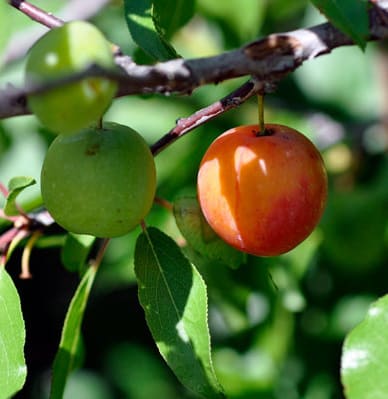
According to the North American plant atlas, the sandhill plum can be found through most of Kansas, except the extreme Northeast area. Similar to the American plum (below), it grows shorter and more compact, and is common in drier soils. It can grow 3 to 10 feet tall. For years, we had some sandhill plums growing in my parent’s yard, and I did not know it!
The sandhill plum is an excellent fruit for fresh eating, jelly or jam making, and even wine. The fruits are reddish to orange-red in color when ripe. I have tasted these fruits and they are excellent. 18 species of lepidoptera feed on the leaves or fruit of the sandhill plum, including the Eastern Tiger swallowtail butterfly and the one-eyed sphinx moth. The fruit is also eaten by various birds and mammals.
Red Mulberry – Morus rubra
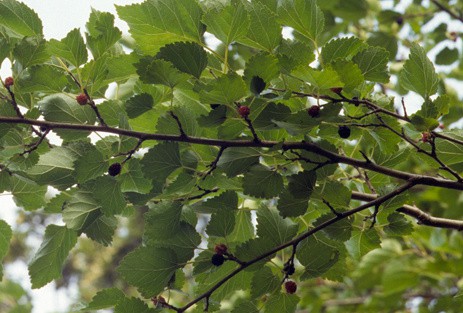
This tree is easily confused with the invasive white and black mulberries from Asia. However, the native red mulberry has larger leaves that are rough and not shiny. If you can identify mulberries, then you will be able to see the shiny smooth leaves of the red mulberry. Red mulberry is common throughout the Eastern half of the state of Kansas, but also found in select states in the Western half.
Red mulberry grows up to 70 feet tall and 3o feet wide, with a few exceptions. The fruit of the white mulberry is well known for being messy in landscapes and on sidewalks, but the red mulberry grows mainly in native woodlands. The fruit is dark purple and up to 1 inch long. White mulberry fruit is up to 1/2 inch long. There are few, if any, insect associations with red mulberry, though the fruits are eaten by birds and animals.
American Plum – Prunus americana
The American plum would be my own choice for a state fruit of Kansas, if my voice mattered in it. I have always loved this native shrub, both for its flowers and its fruits. When I was in high school, I remember the American plum blooming at the same time as our prom. I put the flowers in my car to make it smell better. It is found throughout Kansas, except in the extreme Southwest.
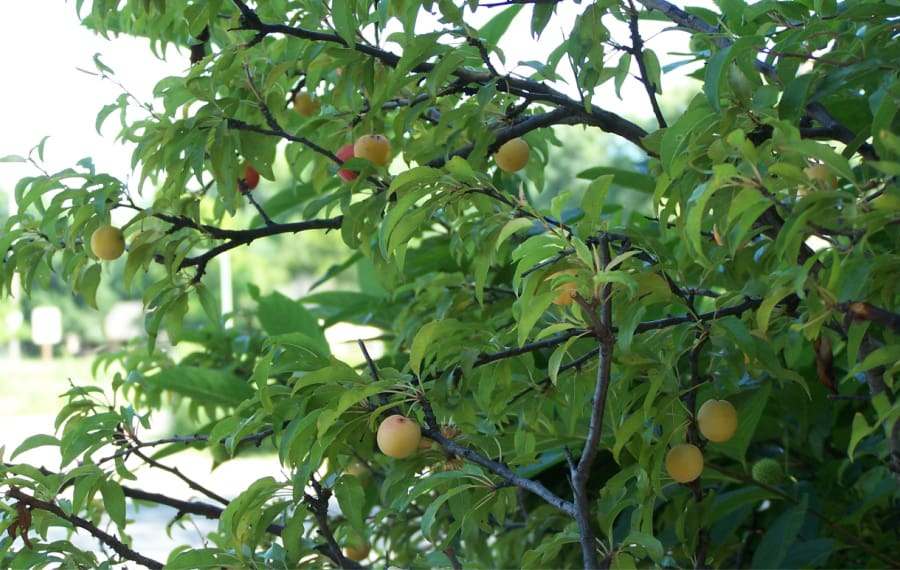
This shrubby fruit grows in large thickets up to 30 feet tall and many feet wide. Some of the stems can produce thorn-like appendages, making it similar to a large bramble thicket. The flowers are very fragrant and visited by many pollinators including early butterflies and bees. Fruit of the American plum is large, similar in size to an apricot and very sweet. Just like the sandhill plum, 18 species of lepidoptera use the American plum as a host plant.
Chokecherry – Prunus virginiana
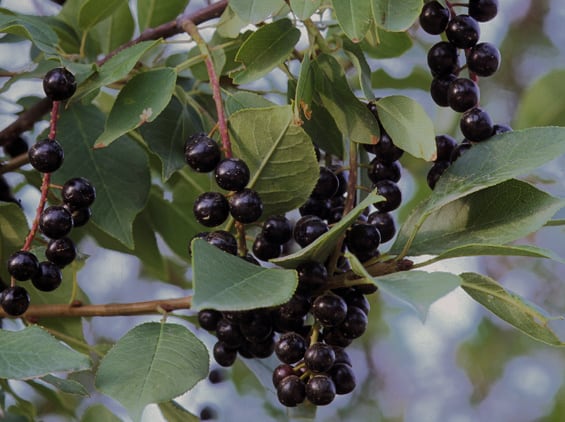
The chokecherry is often disregarded as a fruit, because it is not to be eaten fresh. However, it makes excellent jelly and wine. A relative to the above plums, the chokecherry has similar characteristics. Unlike them, it is found in nearly all Kansas counties. It forms a thicket growing up to 20 feet tall. The fruit grows in long clusters, turning dark purple when ripe.
9 species of moths use chokecherry as a host plant, along with 2 butterflies, the coral hairstreak and the red-spotted purple. The fruit is eaten by a variety of birds and mammals. The flowers are visited by bees, butterflies, and other pollinators.
Clove or Buffalo Currant – Ribes aureum
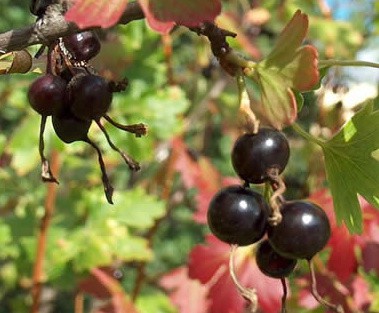
The sweet, clove-like smell of the clove currant flowers are very attractive when you come across one in the wild. Found in most of Kansas, this species of currant also has dark purple fruit that is edible. This would be an excellent choice for the state fruit of Kansas, partly for its wide distribution and partly for the great qualities.
Clove currants grow 5 to 10 feet tall and wide. The bright yellow, highly fragrant flowers are visited by long-tongued bees, hummingbirds, and butterflies. There are very few, if any associations with lepidopteran species, though many other insects feed on the fruit and foliage, including a variety of aphids and fruit flies.
Although not used in landscaping, the clove currant would make an excellent shrub for hedges and screens. Since it attracts hummingbirds, it could be included as a center plant in a circular hummingbird or pollinator garden.
Riverbank Grape – Vitis riparia
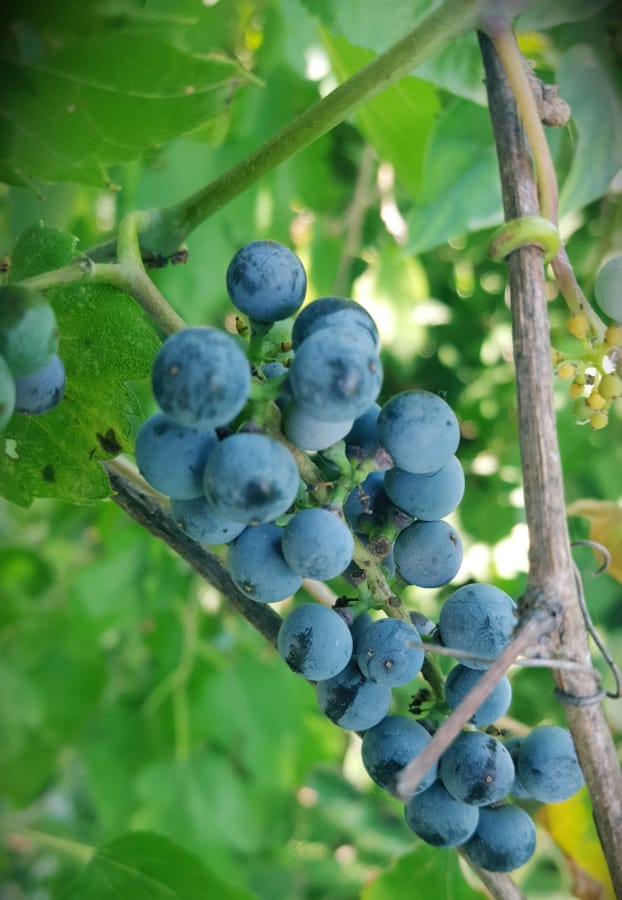
The riverbank grape is the only commonly found vine with edible fruit in Kansas. It can be found in all but 14 of Kansas’s 104 counties, at least as a historical representation. Most likely you can find it in all counties now. Grapevines, also just called vines, can be found throughout the earth.
As far as fruit goes, the riverbank grape is a tasty treat, but with seeds. The slightly bigger than marble sized fruit is blue-black when ripe and is loved by many animals and birds. It grows near bodies of water, but can also be found in woods and disturbed areas. Anywhere birds and mammals scatter the seeds, it can be found.
20 species of moths feed on the leaves or fruit of the riverbank grape. Included in that list are 5 species of sphinx moth, and several very pretty moths. A number of other insects, including grape and Japanese beetles feed on the leaves and fruit. Riverbank grape, although not considered for the Kansas state fruit, could be used in a native garden on a trellis.
Black Elderberry – Sambucus nigra v. canadensis
Also called the American elderberry, this thicket-forming shrub has both edible flowers and fruits, when cooked. If eaten raw, the whole plant can cause nausea, vomiting, and other ailments. Despite this, the cooked fruit is very high in vitamin C and antioxidants, and is used in a variety of medicinal tonics and syrups. It is also used for wine and jelly making.
Found everywhere but Southwest Kansas, this would be another good fruit for consideration as the Kansas state fruit. It grows mostly in part shade to full sun along streambanks, waterways, and ponds. Black elderberry grows 3 to 10 feet tall and has large umbels of white flowers. The flowers can be dipped in batter and deep fried for a unique treat.
While only a couple of moths use the elderberry as a host plant, there are a variety of insects using the plant for food. Some bees use the hollow stems as a nesting spot and many sawflies and beetles feed on the leaves and stems. The berries are eaten by many birds and a few mammals.
Prairie Wild Rose – Rosa arkansana
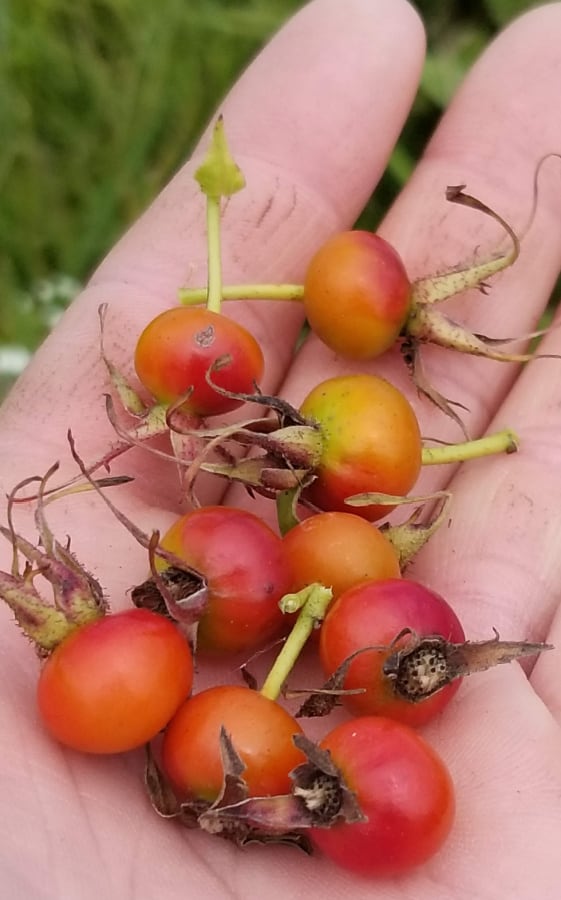
Although roses are not usually considered to be a fruit plant, the rose hips formed after the flowers make this a valuable addition the list of Kansas state fruits. Found in all but 16 counties in Kansas historically, the prairie wild rose is an exceptional plant. Valuable for pollinators and its edible qualities, the rose is a favorite among gardeners.
While there are many invasive rose species in the United States, the prairie wild rose is a tough competitor for landscapes. Unused in the gardening world, it grows along country roadsides, in ditches, and along highway cutouts and fields. It grows 1 to 2 feet tall and wide, with large, pink or rarely white flowers. The fruit, called hips, are reddish orange and full of vitamin C.
Many insect pollinators visit the open flowers of the wild prairie rose, and many other insects feed on the leaves, stems, flowers, or fruit. Some birds and mammals, including prairie chickens feed on the hips.
Plains Prickly Pear Cactus – Opuntia macrorhiza
Another unusual fruit, this might be the most widespread of all Kansas fruit. Growing natively in all but 8 counties of Kansas, the plains prickly pear is a valuable fruit in many Native American dishes. I myself have tried both the fried pads and the ripe fruit, and found them both to be delectable. The fruit especially is a tasty treat on a hot summer day when botanizing natives in the Flint Hills.
Prickly pears grow in rocky or sandy, well-drained soils that are typically dry. Like I mentioned above, both the pads and the fruits are edible. The fruits are small, orange or red when ripe and may have stiff bristles on the outside. They are can be eaten raw or cooked, and are often used for jam. There are a handful of moths whose caterpillars feed on the pads of the plant, while many insects visit the flowers.
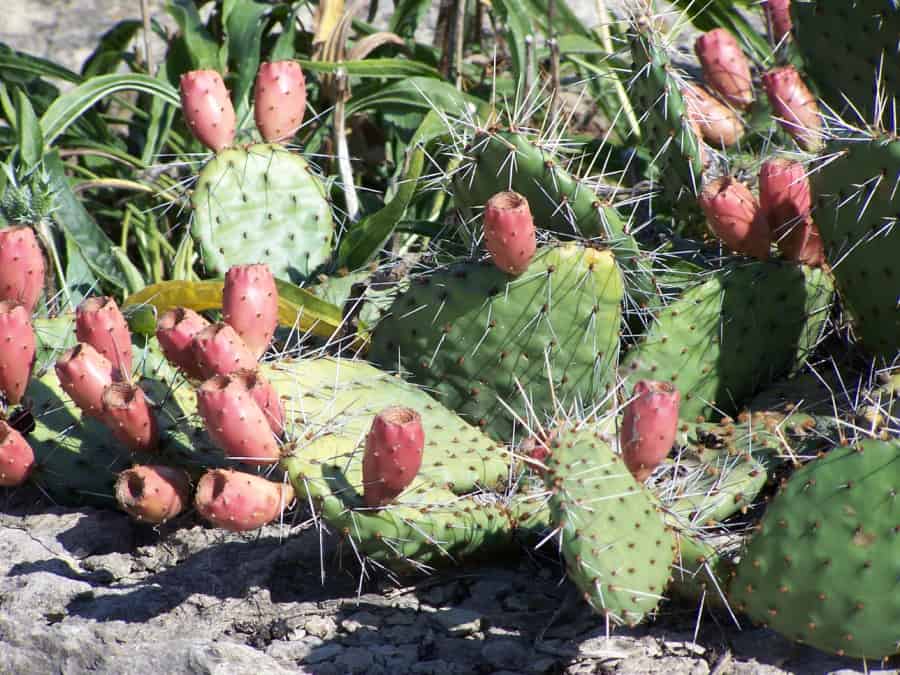
The Other Choices for a Kansas State Fruit
Common Persimmon – Diospyros virginiana
The persimmon is a strange fruit to be picked for the Kansas state fruit. Persimmons are trees, ranging from 30 to 80 feet tall and are found only in the eastern 1/3 of Kansas. They are adaptable though, and are often planted on homesteads in central and western Kansas.
The fruit itself is strange, and definitely something to eat when very ripe only. If picked and eaten when unripe, the fruit is astringent, similar to putting a cotton ball in your mouth. When ripe, the fruit is used in puddings and cakes historically. the common persimmon is a distant cousin of the Asian persimmons found in grocery stores.
17 species of moths, including the luna moth, use persimmon trees as a host plant. The flowers, which are small and not showy, are visited by a variety of bees and other pollinators. One of the most interesting characteristics is the bark of the tree, which is blocky and quite easy to identify.
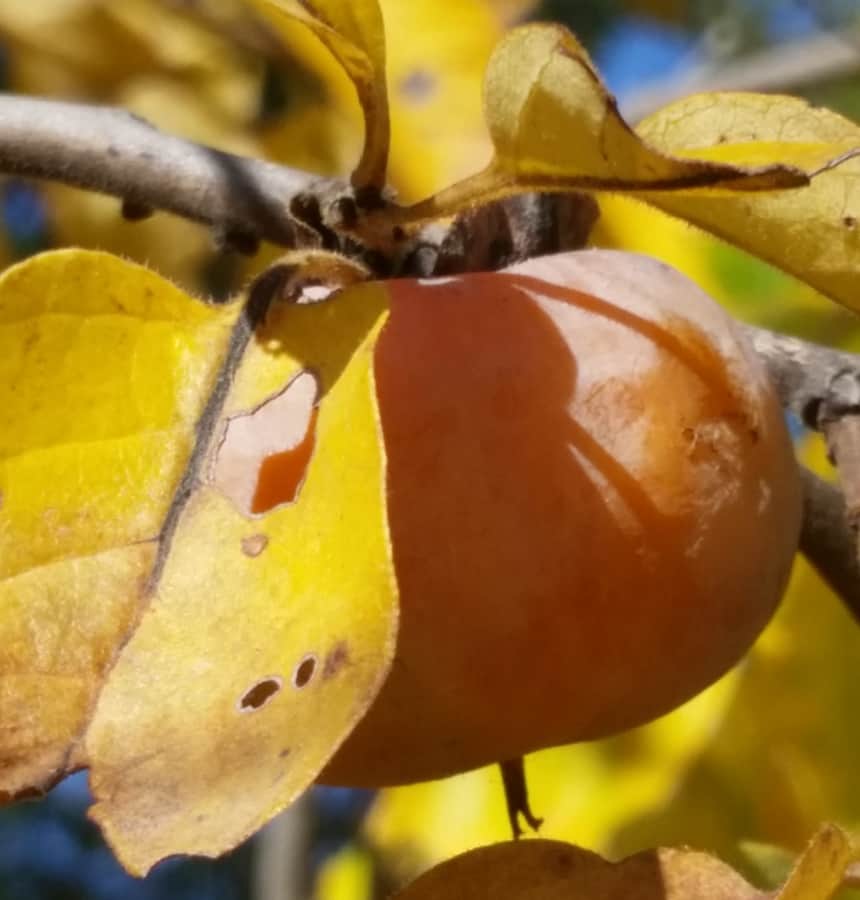
Missouri Gooseberry – Ribes missouriense
Unlike its cousin the clove currant, the Missouri gooseberry is not widespread across Kansas. It is found mostly in the eastern half of the state, in wooded areas. It grows 2 to 4 feet tall and has very prickly stems. If hiking in the woods of Kansas, you would notice the presence of Missouri gooseberry very quickly.
As far as fruit goes, I am very fond of gooseberries, both wild and domesticated. They are excellent in pies and jam and are a sour to sweet taste when fresh. On the plant, berries are ripest when red or black, but can be eaten greenish as well, though very tart.
Many pollinators visit the upside-down flowers including bees and clearwing moths. The leaves and fruit are used by 12 species of lepidoptera including the gray comma and the cecropia moth. Birds and mammals feed on the ripe fruit.
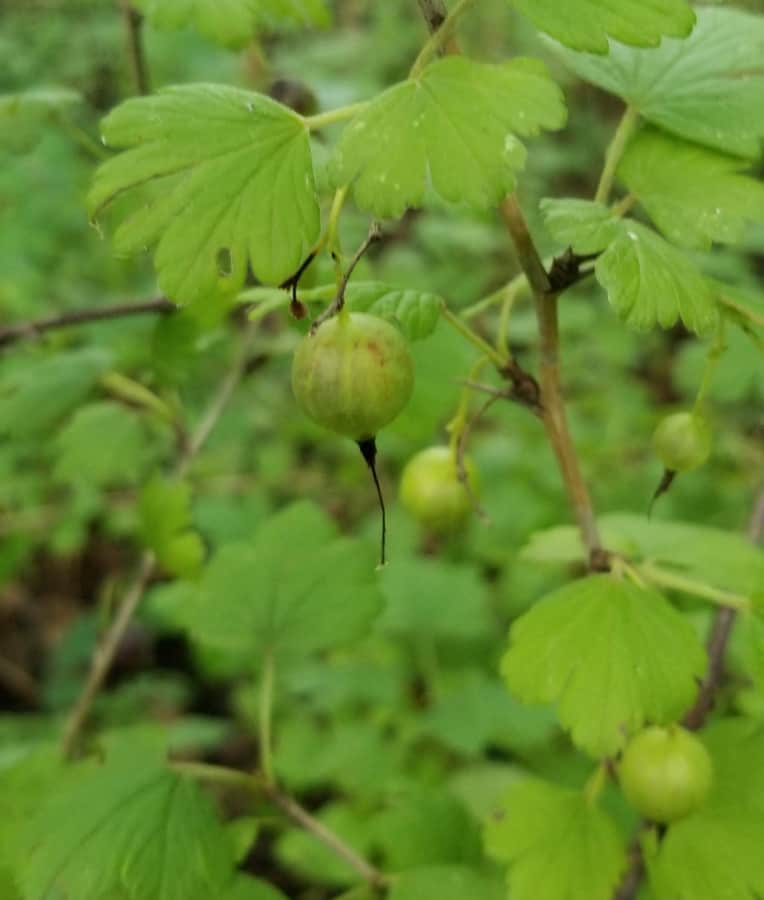
Other Native Fruit of Kansas
Besides the 11 species mentioned above, there are 56 other species of fruit native to various areas of Kansas. That seems like a large number for a state that is considered a flyover state, does it not? Well, Kansas has a diverse landscape, including forests, plains, desert, and sand dunes. Let us look into the different genera of native fruit.
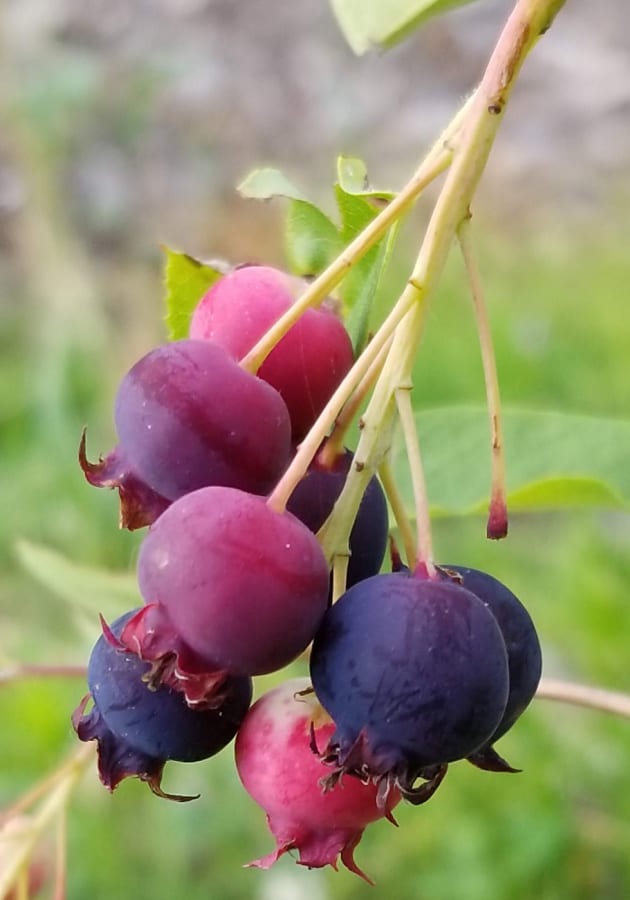
Serviceberries – Amelanchier species
The serviceberry, also known as sarviceberry or Juneberry, is only present in Kansas with 2 species. The berries of the serviceberry are small, blue-black when ripe, similar in taste and size to a blueberry. In fact, they are so similar that they are often grown high pH soils where blueberries cannot thrive.
Serviceberries are one of my favorite fruits for the home garden, and my kids think they are blueberries. The flowers are white and attractive to many insects and fall foliage is orange to reddish. 17 species of moths use various serviceberry species as a host plant.
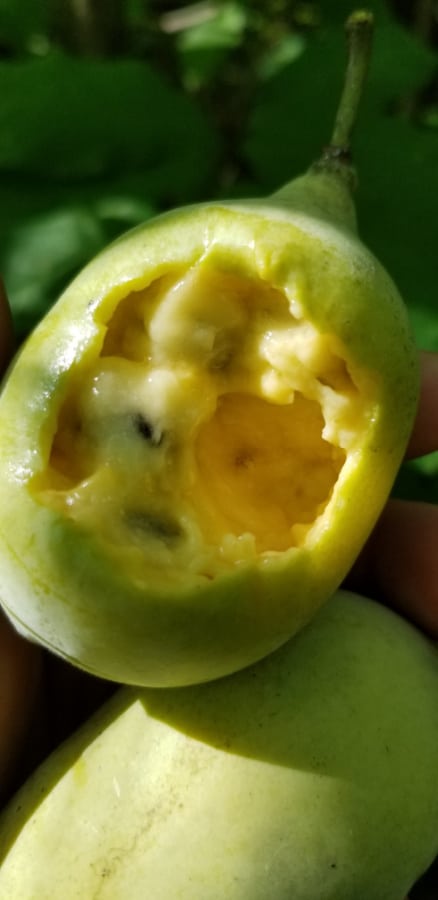
Pawpaw – Asimina triloba
Perhaps my favorite native fruit, this unique tree with tropical tasting fruit grows well as an understory tree in groves. Not only is the fruit tropical tasting, but the large leaves lend a tropical appearance. Pawpaws grow along the eastern 1/4 of Kansas, mainly along rivers and streams. The fruit tastes like a cross between a mango, a banana, and a papaya. It is yellow when ripe and about the size of a twinkie.
The flowers are reddish-brown with a rotten meat smell, and are pollinated mainly by flies. Several mammals go for the ripe fruit, including raccoons and opossums. The pawpaw sphinx moth and zebra swallowtail butterfly are the only lepidopteran species to use it for a host.
Hawthorns – Crataegus species
Found in the eastern 1/3 of Kansas, there are 8 species of hawthorns native. Used primarily as landscape trees, hawthorn fruit are usually called mayhaws. The berries of this small to medium sized tree are red when ripe and can be used to make jelly, wine, and juice. Most hawthorns have long thorns on the trees, making them difficult to prune and shape.
At least 26 species of moth and butterfly are known to use hawthorns as a host plant. The white flowers in early spring are quite showy, and attractive to bees and butterflies, as well as other pollinators.
Wild Strawberry – Fragraria virginiana
The wild strawberry is the only native strawberry in Kansas, located in the eastern 1/3 of the state. The berries are bright red, but much smaller than store bought berries. The wild strawberry has been used in breeding however to produce domesticated berry varieties. Quite flavorful, the wild strawberry makes an excellent groundcover in a native woodland bed.
While many birds and mammals make use of the fruit, only 1 butterfly uses the leaves as a host plant. Bees and other pollinators visit the small flowers.
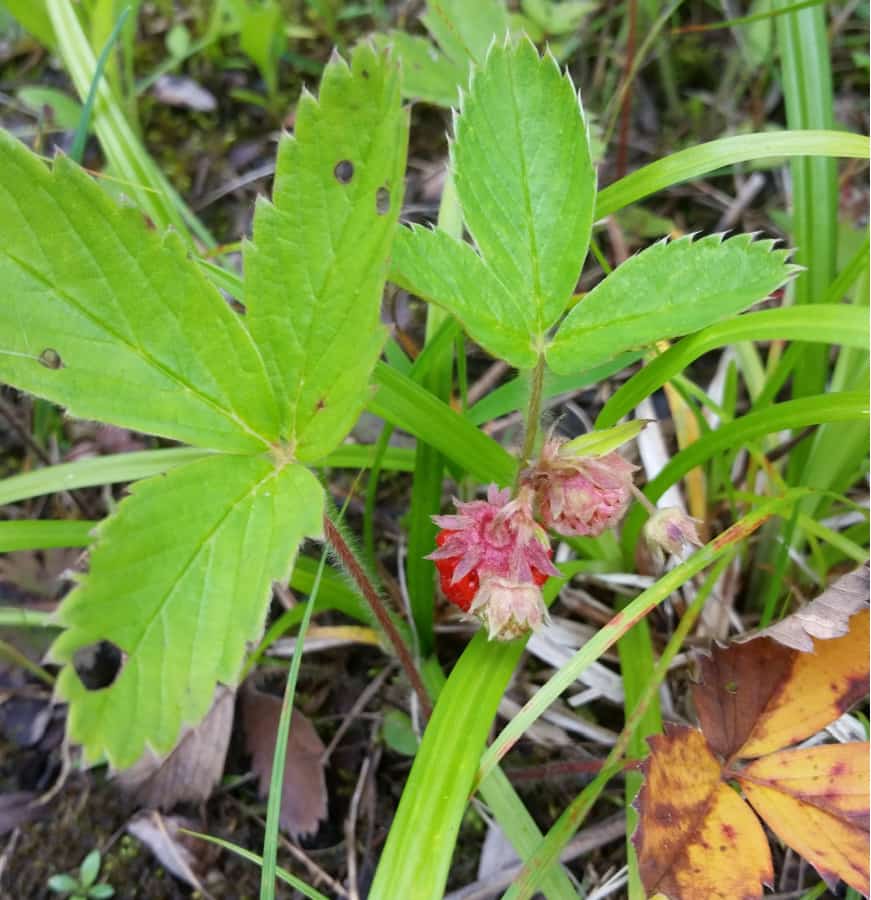
Prairie Crabapple – Malus ioensis
A crabapple native to Kansas? Yes, the Iowa or prairie crabapple can be found in the northeast corner of Kansas, including Brown county, where Grimm’s Gardens is. Crabapples are mostly associated with landscaping, and most species are from Europe or Asia. The fruit of the prairie crabapple is small and not much used for eating, except in jelly making.
The prairie crabapple can be difficult to find growing wild, as most of its habitat has been destroyed, but it can occasionally be found in hedgerows or along railroads. Many insects including aphids, sawflies, and beetles feed on the leaves, fruit, and trunk of the trees. Birds and some mammals eat the ripe fruit.
Prickly Pear Cacti – Opuntia species
Besides the plains prickly pear mentioned above, there are 5 other species of prickly pear cacti found in various environments of Kansas. The fruit can be red or orange in color and both it and the pads of some of these species are edible. Add all the species locations together, and you cover nearly every county in Kansas.
Passionflower – Passiflora species
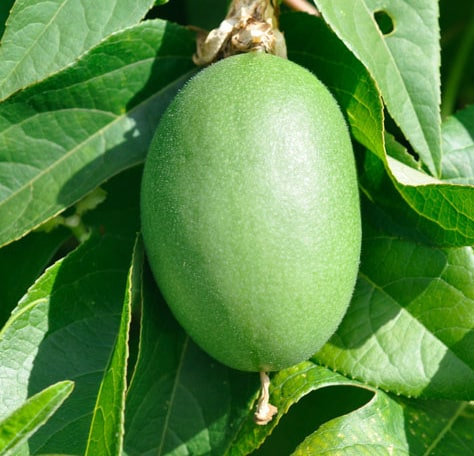
Passionflowers are a subtropical looking vine that are native to the southeastern corner of Kansas. We have 2 species that can be found there. The passionflower is generally not considered a fruit, because the flowers are so showy, but they do produce edible fruit. While I have not personally tried the fruit, I have grown passionflower vines for their beautiful and interesting flowers.
Besides being a showy vine with edible fruit, this vine is a host plant for 3 lepidopteran species, including the gulf fritillary butterfly. Bumblebees and other pollinators visit the showy flowers.
Cherries and Plums – Prunus species
I have already touched on some of the more common species in the Prunus genus, but there are 7 more species in Kansas producing fruit. I am not going to go through each subspecies either, but just touch on a one with economic potential. According to maps, there is a native cherry or plum in all but 2 counties in Kansas.
Black Cherry (Prunus serotina) is a large, hardwood tree found in the eastern 1/3 of Kansas. The heartwood is used in furniture and flooring, while the dark red or black berries are used for flavorings. Birds eat the fruit readily and it is difficult to find once ripe. The bark is flaky and interesting, and the spring flowers are quite showy. At least 30 species of butterfly and moth use this tree as a host plant, including the tiger swallowtail butterfly.
All the other prunus species not previously mentioned are various types of wild plums found throughout different regions of Kansas, but with no major population areas. They are all valuable for their fruit and the role they play in their respective ecosystems. The following is a list of the other Prunus species in Kansas.
- River plum (P. rivularis)
- Oklahoma plum (P. gracilis)
- Hortulan Plum (P. hortulana)
- Mexican Plum (P. mexicana)
- Munson Plum (P. munsoniana)
- Sand Cherry (P. pumila)
Roses – Rosa species
Besides the wild prairie rose, there are 5 other species of native rose species in Kansas. None of these other roses are widespread, but are found in various habitats across the state. They all produce edible fruit, called hips. The hips can be steeped to make tea, or turned into jam. The flowers attract a variety of pollinators and the petals are also edible.
Blackberry and Raspberry – Rubus species
Despite being native in only the eastern 1/2 of the state of Kansas there are 12 species of Rubus. These include blackberries, raspberries, dewberries, and others. It can be quite challenging to separate identification of the different species, at least without a key to each one. The following is a list of the various species.
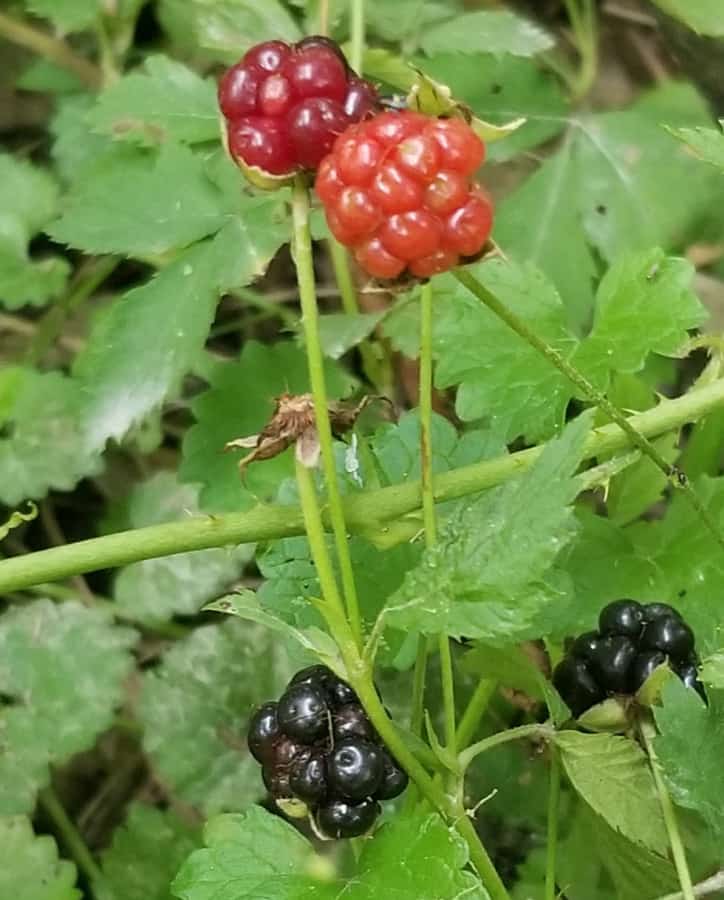
- Garden Dewberry (R. aboriginum)
- Allegheny Blackberry (R. allegheniensis)
- Oldfield Blackberry (R. alumnus)
- Bush’s Blackberry (R. bushii)
- Northern Dewberry (R. flagellaris)
- Yankee Blackberry (R. frondosus)
- Windswept Prairie Dewberry (R. hancinianus)
- Softleaf Blackberry (R. mollior)
- Black Raspberry (R. occidentalis)
- Pennsylvania Blackberry (P. pennsylvanicus)
- Lucretia Dewberry (P. roribaccus)
- Southern Dewberry (R. trivialis)
Blueberries – Vaccinium species
Yes there are a few species of blueberries native to Kansas. However, they are considered rare in the state and only located in the extreme southeast corner, in Cherokee county. Blueberries are unique plants in the Heath family, and have bell shaped flowers which are pollinated mainly by specialist bees. The fruits are quite edible. The 3 rare species in Kansas are the Deerberry (V. stamineum), Bilberry (V. pallidum), and Farkleberry (V. arboreum).
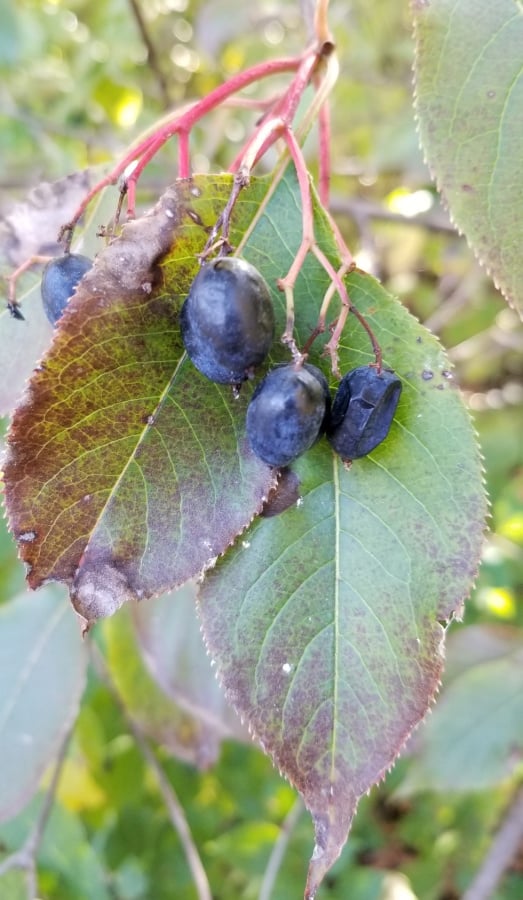
Viburnums – Viburnum species
There are 3 species of viburnums native to Kansas, found in the eastern 1/4 of the state. 1 species is rare in the state, the smooth arrowwood (V. recognitum). However, the blackhaw (V. prunifolium) and the southern blackhaw (V. rufiduum) are more widespread. All of these species have edible berries. Viburnums also host 13 species of moths and butterflies including the spring/summer azure butterfly.
Grapes – Vitis species
I have already gone over the most common grape species in Kansas, the riverbank grape (V. riparia), but there are 4 other species of native grapes. All grapes are possible for breeding with European grapes for better production and flavors. Other species in Kansas include the Fox Grape, Mapleleaf Grape, Summer Grape, and Graybark Grape.
Buffaloberry – Shepherdia argentea
Rare and present in only one county in northwest Kansas, the buffaloberry is a strange and yet edible fruit. Many would have no idea of either this fruit’s existence, nor its edibility. It is useful for erosion control and hedges, and the berry should be consumed in moderation. A member of the oleander family, the buffaloberry has saponin compounds in the fruit.
Conclusion
There are many different native fruits in the state of Kansas that could be chosen as a representation for all. When choosing a state fruit, we should look at all aspects of the individual fruit, from economic value to edibility to native distribution across the state. By selecting a state fruit we can open the discussion into all the native fruits of Kansas.
Happy planting!

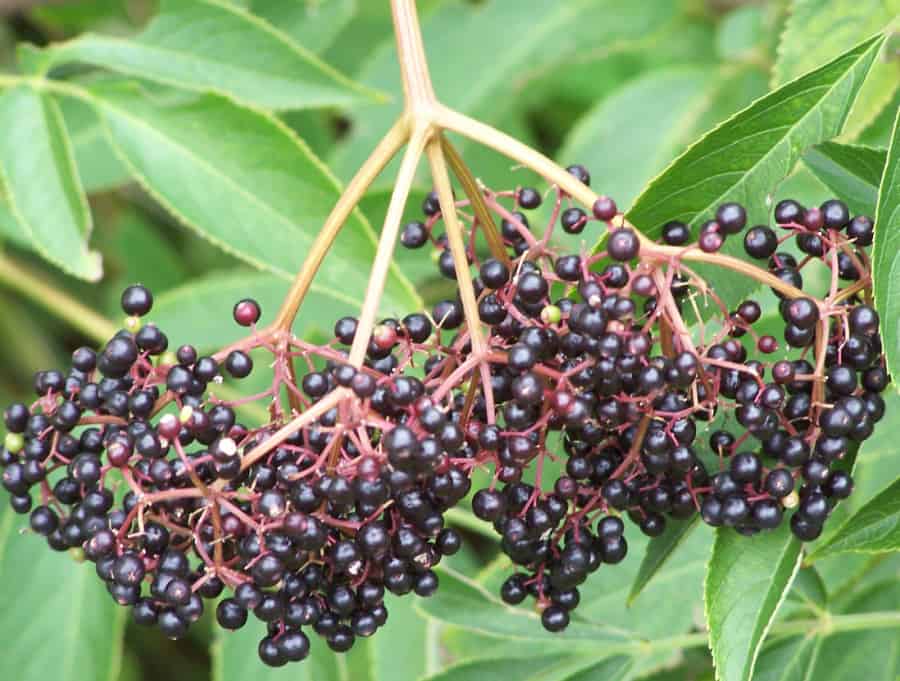



I very much enjoyed this article and all the information contained in it as well as the research you must have done. I have grown and tasted the fruit of the passiflora incarnate, however I am unfamiliar with the 2nd passion fruit species capable of being grown in Kansas.